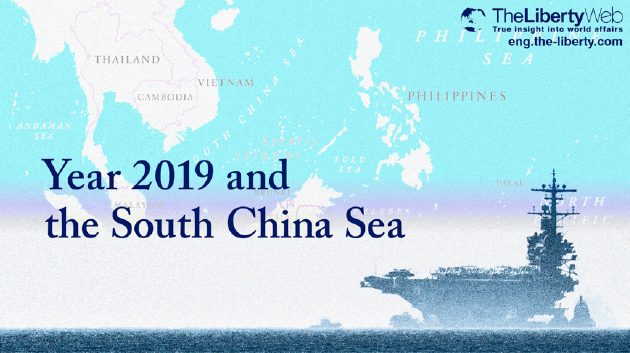Year 2019 And the South China Sea
Next year world politics will revolve around the U.S.-China conflict.
Both countries may be open to compromise on the trade and tariffs problem, but the South China Sea is one problem where compromises are unacceptable.
This problem will give us insight into how the year 2019 might turn out.
In November, the G20 Summit was held in Buenos Aires. But when the leaders from the top 19 countries and EU that make up 90% of the world’s GDP gathered for their commemorative photo, almost none of them spoke to Xi Jinping, and most of them kept him at a distance. It was strangely symbolic of how the world now thinks of China.
The centerpiece of attention at the G20 summit was whether the U.S. would decide to increase their tariffs against China beginning in January 2019. The final decision, however, was postponed for 90 days.
The Quad As Countermeasure for China’s Belt-Road Initiative
2018 is said to be the year the U.S.-China Cold War began. Economic issues were particularly notable, and 2018 was also the year the U.S. turned on the offensive against China’s “One Belt, One Road” economic ideology.
The “One Belt, One Road” is China’s debt-trap diplomacy where they loan large sums of money to countries in Asia and Africa, and when these countries fail to return the debt, China comes in and assumes control of their harbors and seaports.
So, in response, the Quad (a security dialogue between Australia, India, Japan and the U.S.) decided to reconvene for the aim of establishing a “Free and Open Indo-Pacific”. The Quad strategically unites the powers against China in providing high quality infrastructure maintenance to countries in Asia and Africa at low interest rates.
In other words, it is a plan for saving countries from the Chinese loan shark apparatus.
Which Side to Take, The U.S. or China?
In 2019, China will celebrate the 70th anniversary of her founding, and is expected to expand their sphere of influence through economic weapons at the “One Belt, One Road” Summit scheduled for April and at the ASEAN Summit in June.
The U.S. will no doubt respond by inviting countries into the Free and Open Indo-Pacific strategy at the G20 Summit scheduled for June, and the G7 Summit in August. We cannot forget about Brexit or the Tokyo International Conference of Africa’s Development (TICAD) that will also happen next year.
In 2019 the “One Belt, One Road” and Indo-Pacific strategies will clash and the world will be split into two sides. Each country will have to make the crucial decision of which side to take.
The primary battleground will probably be the South China Sea, where even now the U.S. and China are dealing blows at each other. This series of articles will look at the South China Sea problem, how it will affect national defense for Japan, and how it will influence the course of events in 2019.
2019 South China Sea: the Eve of Battle
Tensions continue to rise between the U.S. and China around the South China Sea.
In September 2018, a Chinese naval vessel came within 41 meters of a U.S. naval ship that was navigating around the Spratly Islands. Vice President Mike Pence criticized China saying, “China’s militarization and territorial expansion in the South China Sea is illegal and dangerous.”
“Despite such reckless harassment, the United States Navy will continue to fly, sail and operate wherever international law allows and our national interests demand. We will not be intimidated; we will not stand down,” he said.
The U.S. is angry with China about the South China Sea because China made a false promise during the Obama administration that they would not make military facilities in the South China Sea. After that China went on to make military facilities in the South China Sea.
The U.S. navy responded by deploying naval ships and air force jets to freely navigate the area around China’s man-made islands in the South China Sea. The Trump administration is looking to increase military pressure on China.
Is the U.S.-China Clash Inevitable?
The U.S. and China are fighting for predomination over the South China Sea, and geopolitically, the U.S. and China are fated to clash in the area.
Traditional geopolitics divides the world into land powers and sea powers. While countries such as China and Russia are land powers, countries such as Japan, Great Britain and the U.S. would be counted among the sea powers.
Land powers tend to expand in the attempt to secure marine transportation routes, and sea powers tend to form encirclement alliances to prevent land power expansion. In other words, these two powers are fated to clash.
And the place where they clash is is what is known as the Rimland, the outer edge of the Eurasian continent. Countries and seas on the Rimland are directly under threat of land power expansionism.
Geo Political scientist, Nicholas J. Spykman, promoted the importance of the Rimland to world hegemony. He held that those who rule the Rimland rule Eurasia; and those who rule Eurasia rule the world. His idea came to have great influence on U.S. diplomacy.
After WWII, the U.S. decided to form the NATO alliance with other sea powers such as Japan and Britain to encircle the Soviet land power. The Rimland strategy has now been taken up in the Quad’s Free and Open Indo-Pacific strategy against China.
But China also has their own Rimland strategy, and they are advancing into the Indian Ocean area.
First on the Pacific side, they plan to control the area through Japan, Taiwan and the Philippines through to the South China Sea. Then they will advance across the Izu and Ogasawara islands through to Guam and Saipan.
On the Indian Ocean side, they will reinforce their sea power around the “One Road, One Belt” Silk Road by sea. They have already made deals with the Maldives, Pakistan, Bangladesh, Myanmar, Sri Lanka, and Kenya. China holds rights to their harbors and seaports in exchange for providing facility maintenance. These will act as de facto naval bases for the Chinese navy.
China has already declared that they have become a sea power. This confidence for audacity they gained from slowly building naval checkpoints along their sea route.
During the Cold War against the Soviet Union, Eastern Europe became the central battlefield on the Rimland. But now, with China as the hypothetical enemy, the central battleground will shift to Japan and South East Asia.
If you leave the Rimland in the hands of China, totalitarianism will prevail in the world, and liberty and freedom will be lost, which America will not tolerate. The clash between China and the U.S. will be inevitable.
China’s Ambition And the South China Sea
When a land power country tries to become a sea power, there will be war. And the South China Sea will act as an explosive in the coming war. China has said that the area is a “core interest” and is prepared to make war in their effort to maintain their influence upon it.
The South China Sea is a vital area. Over half of the world’s marine transportation travels across the South China Sea, as do one-third of all naval vessels. Over 90% of Japan’s oil imports pass through the South China Sea, so for them it is life sustaining.
It also has the second largest oil deposits (after Saudi Arabia) and also has good fishing resources. Considering that China consumes 20% of all the energy produced on Earth, and they are fast running short on food supplies, it is not surprising that they are willing to go to great lengths to secure control over the South China Sea.
Vital Nuclear Strategic Importance
For China to become a superpower on par with the U.S., they must become a rivaling nuclear power. The South China Sea proves to be of vital strategic importance here as well.
“If China can control the South China Sea, they will be free to deploy nuclear submarines in the Pacific and attack the U.S. mainland with nukes,” says Kunio Orita, former Japanese Air Self-Defense Force Air Support Command leader.
If this happens, Japan will lose their protective nuclear umbrella. The U.S. has already considered the possibility that if China creates a man-made island out of Scarborough Shoal and turns it into a military facility, and the U.S. may devise a blockade counterplan. This unforeseen clash could quickly escalate into a war. But when is this likely to happen?
Master Ryuho Okawa, founder and CEO of Happy Science, said in his lecture in Berlin given last October, “The Third World War will occur around the South China Sea. It will occur between 2025 to 2050.” Seiji Kawada who lectures on national security at Happy Science University says
China realizes that it is dangerous to manipulate Scarborough Shoal until they create a strategy to distract the U.S. army through achieving the nuclear balance or perfecting its large-scale preemptive attack strategy. They will most likely start constructions on Scarborough Shoal after 2025 when the hardline Trump administration ends.
In other words, it is only a matter of time before Japan loses the protection of the U.S. nuclear umbrella.
War With the U.S.
We should also be anxious that the U.S. might topple from its throne of military supremacy.
According to the Center for a New American Security, China will have a total of 260 naval ships by 2030 compared to 199 owned by the U.S. While the U.S. plans to increase their ships to 355 by 2035, they have a role of protecting the whole world, while China can wholeheartedly focus on dominating the Pacific.
The U.S. alone cannot stand up against China. Cooperation with allied countries is imperative.



















